|

The skeleton fossils of giant tapirs in South China discovered in 2016 have integrity of more than 95% and live about 350000-240000 years ago. Photographed by Geng Junyu of Xinhuanet Xinhua Chongqing, November 30 (Han Menglin) Recently, the activity of "Commemorating the centennial of scientific discovery of Yanjinggou fossil origin in Wanzhou District" was held at the fossil restoration center of "Chongqing Key Laboratory for the Co evolution of Paleontology and Paleoenvironment in Sichuan and Chongqing". The activity site showed the giant tapirs, giant pandas There are 3 fossil specimens with high integrity in the skeleton of Daye Niugu subspecies. Among them, the skeleton fossils of South China giant tapir and Dayan Niugu subspecies with integrity of more than 95% are the most complete skeleton fossils found in the world so far. It is reported that from 2016 to 2019, Chongqing Municipal Planning and Natural Resources Bureau, in cooperation with Chongqing China Three Gorges Museum and Chongqing Three Gorges Immigration Memorial Hall, organized and carried out a large number of investigations, protection, excavation and research on paleontological fossils in Yanjinggou, and obtained a large number of precious fossil samples, including 24 highly complete skeleton fossils, mainly tapirs, rhinoceroses and cattle. According to the relevant person in charge of the laboratory, reviewing the discovery, excavation, research and protection history of Yanjinggou, understanding the complete process of the origin, replacement and extinction of ancient life is of great significance for promoting the exploration and discovery of the origin and evolution of life, popularizing fossil knowledge to the public, carrying forward the spirit of science, and strengthening environmental awareness. According to reports, Yanjinggou in Wanxian County, Sichuan Province (now Wanzhou, Chongqing), together with prehistoric archaeological sites such as Zhoukoudian in Beijing, Yushe in Shanxi Province, and Nihewan in Hebei Province, represents the earliest fossil concentration area found in China at the beginning of last century. Among them, Yanjinggou is one of the most classic places of origin of Quaternary mammal fossils in China, and the fauna produced in this area is an important part and typical representative of the "giant panda saber tooth elephant fauna" in South China. Since 1921, Yanjinggou has been famous both at home and abroad for its abundant Quaternary mammal fossils. It is rare in the world to find fossils with large quantity, complete sequence, many categories and well preserved, and is still respected by scholars at home and abroad. So far, the fossil species discovered in Yanjinggou include seven major mammal groups, namely, primate, rabbitiform, rodent, carnivore, long nose, odd hoofed, and even hoofed. Many mammal fossil genera and species named according to Yanjinggou specimens are still in use in the academic world. The fossils of Yanjinggou are collected, studied and exhibited by a large number of museums and scientific research institutions at home and abroad. 
The skeleton fossils of the giant panda Bashi displayed in the Fossil Restoration Center. Photographed by Geng Junyu of Xinhuanet 
According to the paleontological fossils, the complete skeleton of the giant panda was restored. Photographed by Geng Junyu of Xinhuanet The abundant Quaternary mammal fossils in Yanjinggou are precious natural heritage accumulated over millions of years or even longer. It is irreplaceable for us to deeply understand the evolution history of the fauna in this area, restore the history of changes in the paleogeography and paleoclimate of this area, and the inevitability and rationality of the long-term existence and evolution of Yanjinggou fauna in this area. According to Lu Yuchuan, director of the Mining and Conservation Department of Chongqing Municipal Planning and Natural Resources Bureau, Chongqing has divided a 13.36 square kilometer reserve area for the protection of Yanjinggou fossil origin, which is further divided into core area and buffer area. In the Reserve, industrial activities are prohibited, and three mining enterprises have been closed. According to the relevant person in charge of Chongqing Municipal Planning and Natural Resources Bureau, in recent years, Chongqing has been committed to promoting the exploration and discovery of the origin of life. Since the discovery of Chongqing Yunyang world-class dinosaur fossil group in 2015, Chongqing has focused on the Yunyang dinosaur fossil group and carried out a series of protection and research work on the discovered paleontological fossils in the city. So far, more than 30 paleontological projects such as investigation, excavation, protection and research have been arranged and implemented, and fruitful results have been achieved. Relying on the 208 hydrogeological engineering geological team of Chongqing Geological Exploration Bureau, the Bureau has established the key laboratory of "Chongqing Geological Heritage Protection and Research" Bureau, introduced many doctors and highly skilled talents in paleontology, and established a high-level team of paleontology professionals. In 2021, the laboratory was approved as the "Chongqing Key Laboratory for the Co evolution of Paleontology and Paleoenvironment" jointly awarded by the Municipal Science and Technology Bureau and the Science and Technology Department of Sichuan Province. The establishment of this unique provincial and ministerial key laboratory of paleontology in Sichuan and Chongqing will further gather the advantages of paleontology fossil resources and talents in Sichuan and Chongqing, improve the ability of scientific and technological collaborative innovation, and promote the high-level development of paleontology research in Sichuan and Chongqing. So far, Chongqing has carried out rescue excavation and protection of Yunyang dinosaur fossil group, Wanzhou Yanjinggou mammal fossil group, and Hechuan Dashi Street dinosaur fossil, and investigated and evaluated some paleontological fossil resources in Xiushan, Youyang, Qianjiang, Hechuan, Yongchuan, Yubei, Dazu, Shapingba and other districts and counties. At present, the project of general survey of paleontological fossil resources in Chongqing is being implemented to fully understand the distribution of paleontological fossil resources in Chongqing. A large number of precious complete mammalian fossil skeletons have been excavated in Yanjinggou, Wanzhou, filling many gaps in China; In Hechuan, the largest dinosaur in Chongqing was newly found, repaired and mounted; The earliest dinosaur footprint fossils of sauropods in Asia were found in Dazu. The underground "Great Wall of Dinosaur Fossils" with a length of at least 18 kilometers was found in Yunyang County, which has formed the largest single Jurassic dinosaur fossil wall in the world; Obtained tens of thousands of dinosaur skeleton fossils, discovered and named four new dinosaur species; The discovery and establishment of a new dinosaur fauna filled the gap in the evolution sequence of dinosaurs. Relying on world-class dinosaur fossil resources, Yunyang County has successfully applied for the Yunyang Pu'an Dinosaur Fossil National Geopark. At present, it is striving to build the Jurassic Dinosaur World Scenic Spot, which will strongly drive local economic and social development after completion. The largest Cambrian laminated petrochemical rock group in southern China was found in Youyang. The Dieshi Flower Valley scenic spot built by relying on fossil resources in Youyang County has embarked on a road of "culture+tourism+poverty alleviation" for rocky desertification land governance and green ecological development, which is also a vivid practice of the strategy of paleontology to help rural revitalization. Recently, Chongqing Municipal Bureau of Planning and Natural Resources, in cooperation with the team of academician Zhu Min from the Institute of Vertebrate Paleontology and Paleoanthropology of the Chinese Academy of Sciences, discovered the Silurian fish fossil fauna in Xiushan, Chongqing, which is a new major breakthrough in the history of vertebrate evolution research, providing unique and important empirical data for the early evolution research of jaw, filling in the "from fish to human" Several key gaps in the evolutionary pedigree. 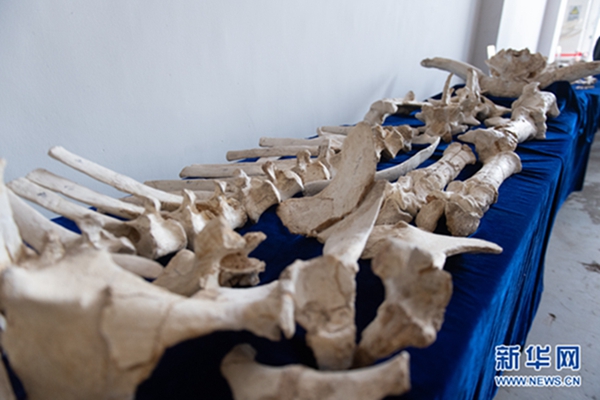
The picture shows skeleton fossils of Dayan Niugu subspecies displayed in the Fossil Restoration Center. Photographed by Geng Junyu of Xinhuanet 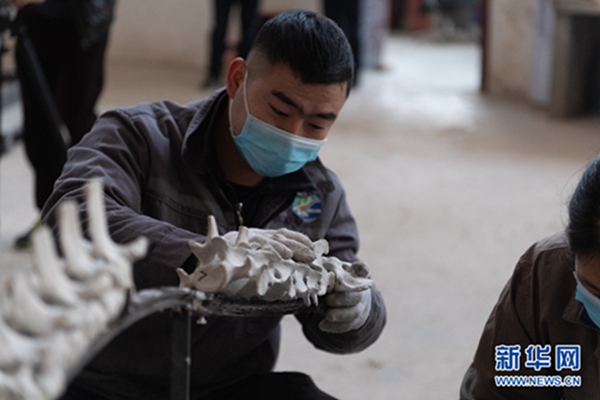
The picture shows that in the Fossil Restoration Center of "Chongqing Key Laboratory for the Co evolution of Paleontology and Paleoenvironment Jointly Constructed by Sichuan and Chongqing", the staff are repairing and erecting the fossils. Photographed by Geng Junyu of Xinhuanet 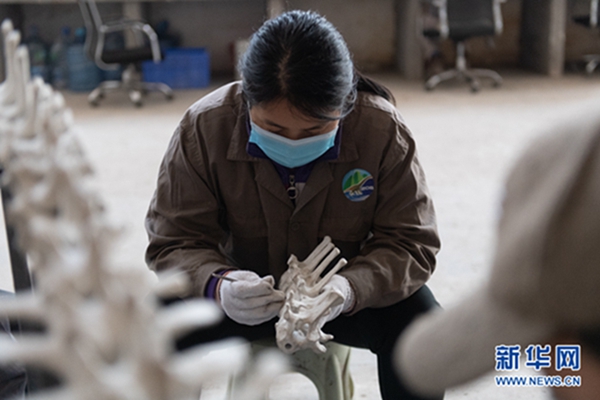
The picture shows that the workers are repairing and installing the fossils. Photographed by Geng Junyu of Xinhuanet 
The picture shows the workers in the Fossil Restoration Center repairing some gaps in the replica model. Photographed by Geng Junyu of Xinhuanet 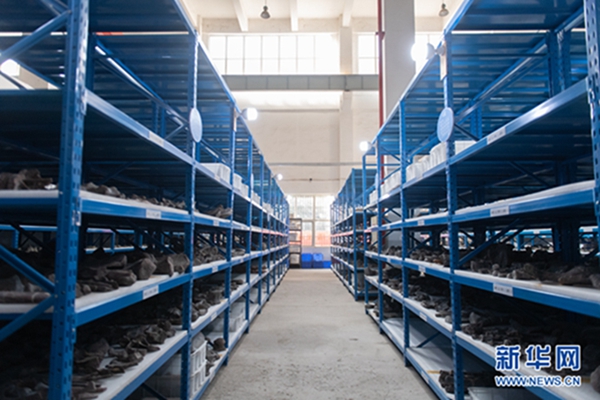
The picture shows the fossil warehouse in the restoration center, where tens of thousands of fossil specimens are stored. Photographed by Geng Junyu of Xinhuanet 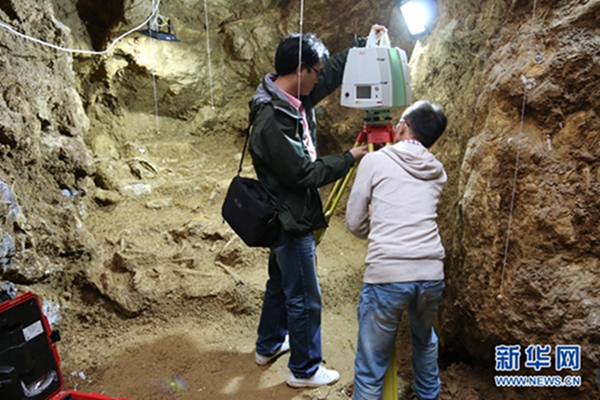
The picture shows the 3D scanning of fossils found by researchers during field work. Xinhuanet (photo provided by respondents) 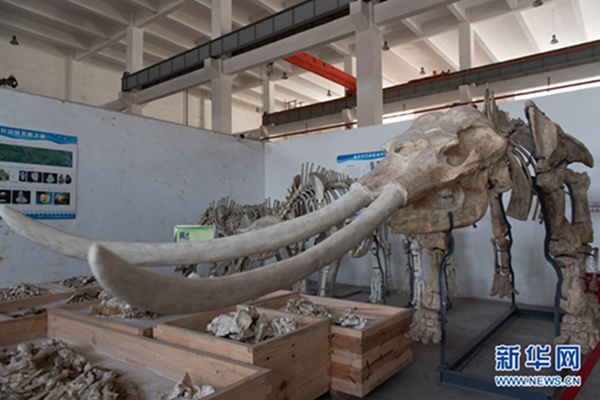
Paleontological fossils record the history of earth evolution and biological evolution, are precious geological relics and non renewable natural heritage, and are also the most direct and important scientific basis for studying the origin and evolution of life. Photographed by Geng Junyu of Xinhuanet
|